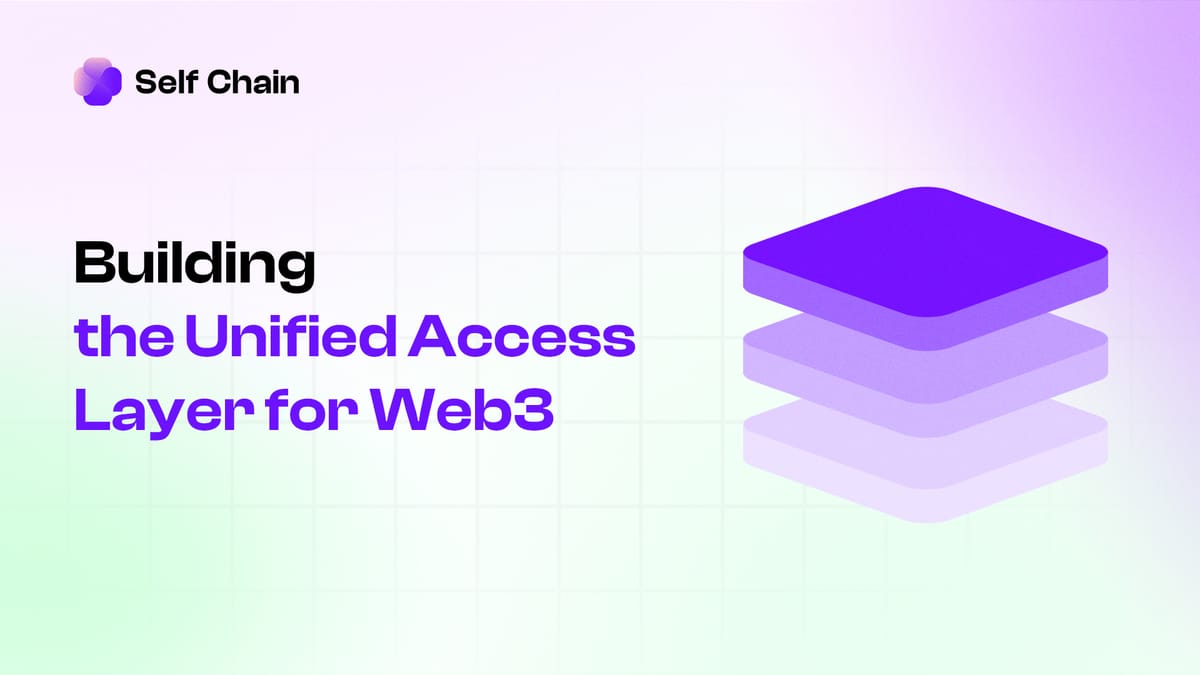Building the Future of Web3 Access

Web3 has grown rapidly in terms of protocol innovation, asset diversity, and cross-chain infrastructure. Yet the way users and systems access these capabilities remains fragmented, fragile, and overly complex.
From wallet management to network switching and manual transaction signing, most access flows in Web3 are still designed for early adopters; not for scale, automation, or composability.
Self Chain addresses this foundational gap by providing a unified access architecture that redefines how interactions happen across chains, interfaces, and execution environments. It is designed for environments where users, AI agents, and applications need to coordinate actions securely and seamlessly, without navigating the limitations of isolated systems.
This architecture isn’t a feature layer or an interface, it is a restructured foundation that enables modular, secure, and agent-compatible access across decentralized ecosystems.
The Architecture of Unified Access
The Self Chain framework is structured around five deeply integrated components, each designed to eliminate a specific point of friction in today’s multi-chain experience.
→ Keyless Wallets:
Built using MPC-TSS and Account Abstraction, they remove the reliance on seed phrases while maintaining recoverability and full user custody. This approach simplifies authentication without compromising security.
→ Chain Abstraction:
Self Chain abstracts away the technical boundaries between blockchain environments. Instead of requiring users to switch networks, manage different assets, or manually bridge liquidity, the chain abstraction layer routes execution through a unified interface. Whether operating on Ethereum, Solana, or other ecosystems, users and agents interact through a consistent access model, with the infrastructure handling the underlying coordination.
→ Intents:
This represent a shift in how actions are defined. Rather than manually making transactions step by step, users define their desired outcomes. Self Chain’s AI-powered intents interpret these high-level goals and resolves them into executable transactions with the aid of Solvers and Searchers. This unlocks greater automation, consistency, and precision.
→ AI Agents:
These are autonomous actors capable of holding wallets, signing transactions, and executing logic across chains, all within a permissioned, verifiable structure.
All of these systems operate on top of a modular Proof-of-Stake Layer 1 network, an execution environment purpose-built to harmonize these capabilities. It enables secure coordination, cross-chain liquidity access, and decentralized computation at scale.
Self Chain’s infrastructure supports a wide range of use cases already emerging across Web3. In PayFi, agents can facilitate recurring, conditional, or token-agnostic payments with no manual intervention. AgentFi allows autonomous agents to manage strategies, rebalance positions, or interact with DeFi protocols on behalf of users. The system also supports coordination of real-world assets (RWA), enabling cross-chain ownership, settlement, and verification without compromising regulatory constraints.
Across all these domains, the focus remains the same: make access intelligent, modular, and unobtrusive, without sacrificing sovereignty or control.
Looking Ahead
Self Chain is committed to building in the open. A public technical roadmap is in development, with weekly and bi-weekly updates planned to ensure transparency as the protocol evolves. This roadmap will outline upcoming releases, priorities, and performance benchmarks.
To foster dialogue and alignment, the Self Chain team is preparing a community session featuring Chief of Operations and advisor, Parul, where the direction and long-term strategy will be discussed in detail.
In parallel, ecosystem growth is underway. Strategic partnerships with infrastructure providers, agent platforms, and global teams are being finalized to support onboarding and expand the utility of the access layer.
Conclusion
Self Chain is a restructuring of the access layer itself. By embedding intent resolution, agent-native operations, and chain abstraction directly into its protocol architecture, Self Chain offers a model of access that is consistent with the direction Web3 is heading.
As the space matures, seamless interaction across systems will no longer be an advantage, it will be a prerequisite. Self Chain provides the foundation to meet that future, with infrastructure built to scale, adapt, and simplify how Web3 is experienced at its core.
About Self Chain
Self Chain is the AI-powered intent layer for Web3, and a Modular L1 simplifying blockchain interactions. By combining keyless wallets (MPC-TSS/AA), intent-driven automation, and seamless multi-chain access, Self Chain eliminates complexity, making Web3 more intuitive, autonomous, and secure.
With Keyless Wallets and AI-powered intent execution, users can seamlessly onboard, manage assets, and interact with dApps without handling private keys or complex transactions. Self Chain’s AgentFi Infra enables autonomous on-chain AI agents to execute transactions, optimize DeFi strategies, and interact across ecosystems, while PayFi powers seamless, real-time blockchain payment systems, aligning with the evolving demands of the emerging global economy. Developers benefit from tools like the Intent SDK, Keyless Wallet SDK, and Account Abstraction Plugins, enabling the next generation of AI-driven applications with enhanced security and efficiency.
